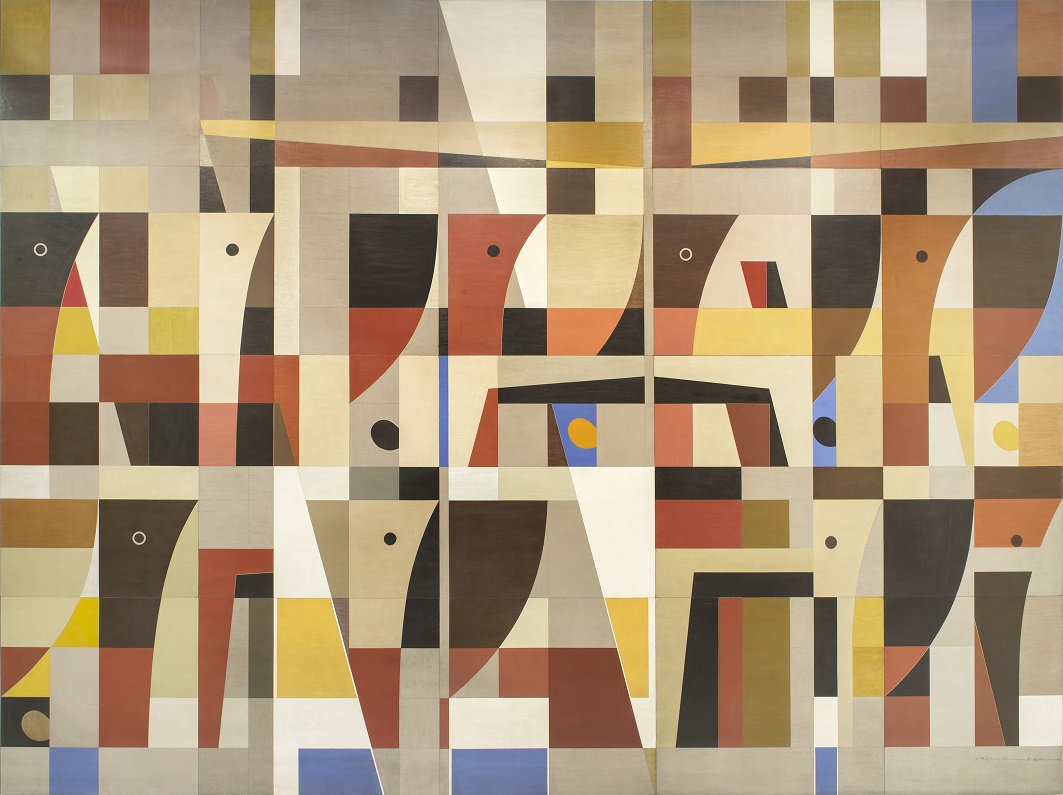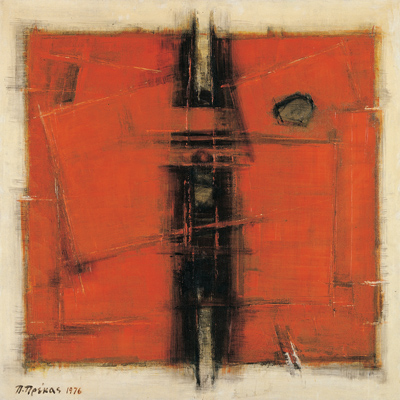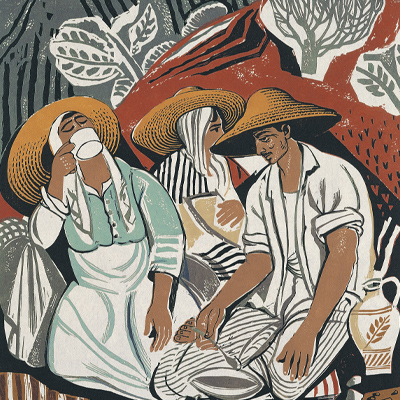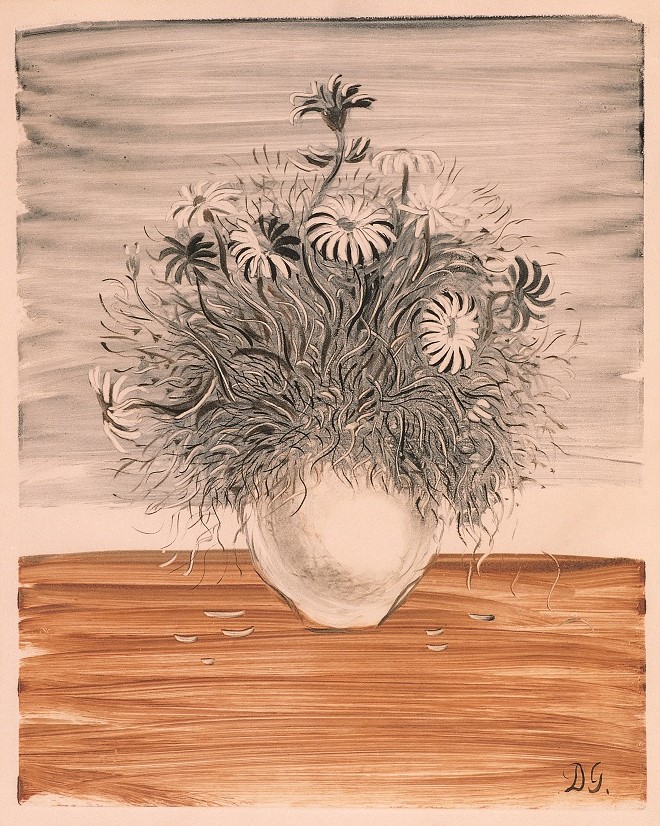Yannis Gaitis, Figures
The painting Figures by Yannis Gaitis is a precursor of his famous later works with the trademark little men. The main elements of the painting are abstraction and symbolism. The aim of the artist is to protest against the massification of modern societies. Gaitis’ works are among the most recognisable in modern-Greek painting. They stand out for their originality and symbolic themes.
Main elements of the composition
The Figures by Yannis Gaitis are powerfully drawn. They are separated in groups within narrow bands. They are placed in a fragmented space, with minimal supplementary elements.
Some of the figures are different from the others. The first one stands out, as the largest one. The last one appears to be standing in front of a window. It is different because it is wearing a hat.
The colour scale is limited to orange, white and black. There is no colour grading or shading.
The main element of the piece is abstraction. Gaitis simply presents the bodies, heads and eyes of the figures. This allows the audience to interpret the figures as they please.
The symbolic character of the painting
The piece is full of symbolism. Its aim is to protest against the mass subjugation of modern society.
Gaitis demonstrates his insightfulness through this prophetic composition. He denounces a social phenomenon that would evolve even more in the future, posing a greater threat to society.
The precursor of the little men
The Figures are a precursor to Gaitis’ later works. His paintings with the identical male figures, the little men, are widely known and show the absolute standardisation and repetition of form.
In Figures, the trademark human figures still maintain some rudimentary differences. They have not yet obtained their recognisable uniform features: the identical pinstripe suits and hats.
The little men are a sign of protest against the massification of modern man.
His life in a nutshell
Yannis Gaitis (1923-1984) was born in Athens. He studied at the Athens School of Fine Arts from 1944 until 1951.
In 1954 he moved to Paris. There he attended classes at the Académie de la Grande Chaumière.
Artistic influences
During his studies in Athens, Gaitis participated in the founding of the art group “Oi Akraioi” (The Extremists). Alekos Kontopoulos was also part of the group, as were other artists who had turned to abstract art.
In the 50s, during his stay in Paris, the painter was influenced by art informel . These influences contributed significantly to him creating his first dynamic figures and restricting his colour palette to white, black, red and blue. The figure of the little man was the natural evolution of the above.
From landscapes to little men
Until 1960 Gaitis’ works were abstract expressionist compositions and cubist landscapes.
Just after the mid-60s he started shaping his personal style around the human figures and their attached symbolisms. This is how he created his famous little men.
The little men were part of a faceless crowd, in the context of modern life and indiscriminate massification. Initially the little man was repeated around a central theme. Then they were given a shape and became standardised.
The spontaneous representation of the modern world through his own perspective for man became a perpetual exploration for the artist.
The little man became the foundation for the artist to create installations and sculptures, and he also used it on clothes, fabrics and toys.
Hardship before recognition
When Gaitis first appeared in the art scene (in the 40s and 50s) his work was not well-received. His refusal to accept the merger of modern art and Greek tradition came in contrast with the trends of the time.
He was very much aware of the fact that his critical stance against the phenomenon of massification may not be easily accepted by the public. As he said: “Today I create the little man. I don’t have the power to change him because the little man represents me perfectly... People do not want to see themselves as little men. This is why they say, ‘Τhat is not me.’ And yet, it is...”
Over time, through his work, he managed to overcome the initial negative expectations. Today his works are readily recognisable, and, what is more, they form their own, independent unit within modern-Greek art. Gaitis’ works stand out for their originality and symbolic themes.
The work of art in our publications
The Figures by Yannis Gaitis are referenced in the Alpha Bank publications:
- The Alpha Bank Collection. Greek Art from 1920 until Today, edited by Irene Orati. The publication accompanied the Art Collection’s exhibition at the Macedonian Museum of Contemporary Art in Thessaloniki.
Buy the publication The Alpha Bank Collection. Greek Art from 1920 until Today on the Alpha Bank e-shop. - The Alpha Bank Collection. Greek Art from 1950 until Today, edited by Irene Orati. The publication accompanied exhibitions of the Collection in Nicosia, Limassol and Larnaca in 2008.
- New Contemporary Works in the Alpha Bank Collection, edited by Irene Orati (in Greek). The publication presents 16 works of art from the Alpha Bank Collection which were created in the last decades.
In other literature
The Figures by Yannis Gaitis are referenced in the publications (in Greek):
- Y. Gaitis. Catalogue raisonné, 2003.
- Bia Papadopoulou, Yannis Gaitis. A Revolutionary Visionary, 2007.
The Alpha Bank Art Collection is not open to the public.
Research visits to the Art Collection can be organised upon request.
Contact us to book your visit.







